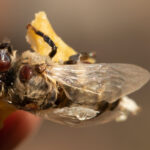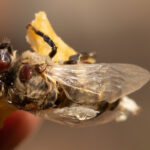Registered commercial beekeepers will be reimbursed for all equipment, hives and bees that are destroyed…
Australia transitions toward Varroa mite management

In a significant development, Australia has recognised the evolving challenges in the battle against the Varroa mite, a notorious parasite that affects honey-bee populations. The National Management Group (NMG), the body overseeing this important fight, confirmed today that the strategy will now adapt to focus on managing the parasite�s impact, marking a new phase in its overall approach.
The Varroa mite, known for causing hive collapses, had been successfully contained within a 10,000-square-kilometre area in NSW for over a year. Newcastle was identified as the epicentre of this containment zone. As recently as June, there was hope that Australia could become the first country globally to completely eradicate the Varroa mite.
However, in August, new challenges emerged when the pest was discovered in hives in Kempsey. This discovery was followed by further detections in the Riverina and Sunraysia regions, close to the Victorian border.
The eradication process led to the unfortunate loss of more than 30,000 hives, which housed up to one billion bees. With reports of 48% annual colony loss in the United States and 13% in New Zealand, colony loss remains a significant concern.
While no infestations have been confirmed in Victoria yet, numerous hives are located within emergency surveillance zones and are prohibited from being moved. The effort to control Varroa mite has so far cost over $100 million.
The NMG has attributed the challenges faced by the eradication strategy to several factors. One notable issue was some beekeepers� illegal movement of hives. Additionally, the recent surge in detections revealed that the infestation was more widespread and had been present for longer than initially thought. This revelation stretched the eradication team�s resources to their technical limit.
As Australia transitions from an eradication strategy to a management approach for dealing with the Varroa mite, an interim strategy is being implemented in NSW to mitigate impacts and slow down its spread while a revised response plan is being developed.
The official statement
In a communiqu� arising from yesterday�s meeting, the Department of Agriculture, Fisheries and Forestry (DAFF) says:
�The National Management Group (NMG) confirmed at its meeting on 19 September 2023 that eradication of Varroa destructor (varroa mite) is no longer feasible based on technical grounds, following advice from the Consultative Committee on Emergency Plant Pests (CCEPP), and has now entered a transition to management phase. The NMG acknowledged the significant and sustained efforts of the New South Wales (NSW) Government and impacted industries over the eradication response phase since June 2022 and the contribution of both government and industry representatives in guiding response activities.
�While a revised response plan (including transition to management activities) is being developed by the CCEPP and agreed to by the NMG, NSW will operate under an interim strategy to limit the impacts and slow the spread of varroa mite. The NSW Department of Primary Industries, AHBIC and other impacted industry groups will be communicating with beekeepers and businesses relying on pollination services currently impacted by the response program around all changes to requirements.
�Varroa mite remains a key threat to Australia’s honey and honey bee pollination plant industries, and it is important that government and industry continue to work together to manage this pest.
�The NMG will meet again in the coming weeks to consider further technical advice from the CCEPP on options for the ongoing management of Varroa mite in Australia.�








